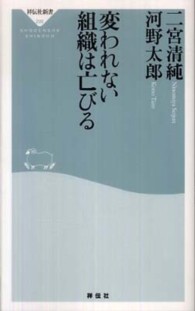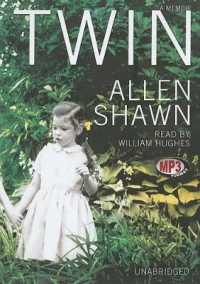- ホーム
- > 洋書
- > 英文書
- > Science / Mathematics
Full Description
Introduction to Statistical Investigations, Second Edition provides a unified framework for explaining variation across study designs and variable types, helping students increase their statistical literacy and appreciate the indispensable role of statistics in scientific research. Requiring only basic algebra as a prerequisite, the program uses the immersive, simulation-based inference approach for which the author team is known. Students engage with various aspects of data collection and analysis using real data and clear explanations designed to strengthen multivariable understanding and reinforce concepts.
Each chapter follows a coherent six-step statistical exploration and investigation method (ask a research question, design a study, explore the data, draw inferences, formulate conclusions, and look back and ahead) enabling students to assess a variety of concepts in a single assignment. Challenging questions based on research articles strengthen critical reading skills, fully worked examples demonstrate essential concepts and methods, and engaging visualizations illustrate key themes of explained variation. The end-of-chapter investigations expose students to various applications of statistics in the real world using real data from popular culture and published research studies in variety of disciplines. Accompanying examples throughout the text, user-friendly applets enable students to conduct the simulations and analyses covered in the book.
Contents
Preliminaries Introduction to Statistical Investigations 1
Section P.1: Introduction to the Six-Step Method 2
Example P.1: Organ Donations 2
Section P.2: Exploring Data 7
Example P.2: Oh, Say Can You Sing? 7
Section P.3: Exploring Random Processes 14
Exploration P.3: Cars or Goats 14
Unit 1 Four Pillars of Inference: Strength, Size, Breadth, and Cause 30
1 Significance: How Strong Is the Evidence? 31
Section 1.1: Introduction to Chance Models 32
Example 1.1: Can Dolphins Communicate? 33
Exploration 1.1: Can Dogs Understand Human Cues? 41
Section 1.2: Measuring the Strength of Evidence 45
Example 1.2: Rock-Paper-Scissors 46
Exploration 1.2: Tasting Water 52
Section 1.3: Alternative Measure of Strength of Evidence 57
Example 1.3: Heart Transplant Operations 58
Exploration 1.3: Do People Use Facial Prototyping? 62
Section 1.4: What Impacts Strength of Evidence? 66
Example 1.4: Predicting Elections from Faces? 66
Exploration 1.4: Competitive Advantage to Uniform Colors? 72
Section 1.5: Inference for a Single Proportion: Theory-Based Approach 75
Example 1.5: Halloween Treats 77
Exploration 1.5: Eye Dominance 80
2 Generalization: How Broadly Do the Results Apply? 117
Section 2.1: Sampling from a Finite Population: Proportions 118
Example 2.1: Voter Turnout 119
Exploration 2.1: Sampling Words 126
Section 2.2: Quantitative Data 133
Example 2.2: Sampling Students 134
Exploration 2.2: Sampling Words (cont.) 138
Section 2.3: Theory-based Inference for a Population Mean 143
Example 2.3: Estimating Elapsed Time 143
Exploration 2.3: Sleepless Nights? 150
Section 2.4: Other Statistics 154
Example 2.4: Estimating Elapsed Time (cont.) 154
Exploration 2.4: Backpack Weights 160
3 Estimation: How Large Is the Effect? 187
Section 3.1: Statistical Inference: Confidence Intervals 188
Example 3.1: Can Dogs Sniff Out Cancer? 189
Exploration 3.1: Kissing Right? 194
Section 3.2: 2SD and Theory-Based Confidence Intervals for a Single Proportion 198
Example 3.2: Cyberbullying 198
Exploration 3.2: How Mobile Are We? 203
Section 3.3: 2SD and Theory-Based Confidence Intervals for a Single Mean 207
Example 3.3: Used Cars 207
Exploration 3.3: Sleepless Nights? (cont.) 210
Section 3.4: Factors That Affect the Width of a Confidence Interval 213
Example 3.4: American Cat Ownership 214
Exploration 3.4A: Holiday Spending Habits 216
Exploration 3.4B: Reese's Pieces 218
4 Causation: Can We Say What Caused the Effect? 245
Section 4.1: Association and Confounding 246
Example 4.1: Night Lights and Nearsightedness 247
Exploration 4.1: Home Court Disadvantage? 250
Section 4.2: Observational Studies Versus Experiments 252
Example 4.2: Lying on the Internet 253
Exploration 4.2: Have a Nice Trip 257
Unit 2 Comparing Two Groups 278
5 Comparing Two Proportions 279
Section 5.1: Comparing Two Groups: Categorical Response 280
Example 5.1: Buckling Up? 280
Exploration 5.1: Murderous Nurse? 285
Section 5.2: Comparing Two Proportions: Simulation-Based Approach 288
Example 5.2: Swimming with Dolphins 289
Exploration 5.2: Is Yawning Contagious? 297
Section 5.3: Comparing Two Proportions: Theory-Based Approach 304
Example 5.3: Parents' Smoking Status and Their Babies' Sex 305
Exploration 5.3: Donating Blood 311
6 Comparing Two Means 346
Section 6.1: Comparing Two Groups: Quantitative Response 347
Example 6.1: Geyser Eruptions 347
Exploration 6.1: Cancer Pamphlets 350
Section 6.2: Comparing Two Means: Simulation-Based Approach 354
Example 6.2: Dung Beetles 354
Exploration 6.2: Lingering Effects of Sleep Deprivation 363
Section 6.3: Comparing Two Means: Theory-Based Approach 369
Example 6.3: Violent Video Games and Aggression 369
Exploration 6.3: Close Friends 378
7 Paired Data: One Quantitative Variable 407
Section 7.1: Paired Designs 408
Example 7.1: Can You Study with Music Blaring? 408
Exploration 7.1: Rounding First Base 411
Section 7.2: Simulation-Based Approach to Analyzing Paired Data 413
Example 7.2: Rounding First Base (cont.) 414
Exploration 7.2: Exercise and Heart Rate 420
Section 7.3: Theory-Based Approach to Analyzing Data from Paired Samples 425
Example 7.3: Dad Jokes? 425
Exploration 7.3: Comparing Auction Formats 431
Unit 3 Analyzing More General Situations 456
8 Comparing More Than Two Proportions 458
Section 8.1: Comparing Multiple Proportions: Simulation-Based Approach 459
Example 8.1: Coming to a Stop 460
Exploration 8.1: Recruiting Organ Donors 466
Section 8.2: Comparing Multiple Proportions: Theory-Based Approach 470
Example 8.2: Sham Acupuncture 471
Exploration 8.2A: Conserving Hotel Towels 476
Exploration 8.2B: Nearsightedness and Night Lights Revisited 480
Section 8.3: Chi-Square Goodness-of-Fit Test 484
Example 8.3: Fair Die? 484
Exploration 8.3: Are Birthdays Equally Distributed Throughout the Week? 490
9 Comparing More Than Two Means 519
Section 9.1: Comparing Multiple Means: Simulation- Based Approach 520
Example 9.1: Comprehending Ambiguous Prose 520
Exploration 9.1: Exercise and Brain Volume 525
Section 9.2: Comparing Multiple Means: Theory-Based
Approach 529
Example 9.2: Recalling Ambiguous Prose 530
Exploration 9.2: Comparing Popular Diets 538
10 Two Quantitative Variables 565
Section 10.1: Two Quantitative Variables: Scatterplots and Correlation 566
Example 10.1: Why Whales Are Big, but Not Bigger 567
Exploration 10.1: Height and Winning at Tennis 571
Section 10.2: Inference for the Correlation Coefficient: Simulation-Based Approach 576
Example 10.2: Exercise Intensity and Mood Changes 576
Exploration 10.2: Draft Lottery 580
Section 10.3: Least Squares Regression 585
Example 10.3: Height and Winning at Tennis (cont.) 585
Exploration 10.3: Predicting Height from Footprints 590
Section 10.4: Inference for the Regression Slope: Simulation-Based Approach 596
Example 10.4: Do Students Who Spend More Time in Non-Academic Activities Tend to Have Lower GPAs? 596
Exploration 10.4: Predicting Brain Density from Number of Facebook Friends 599
Section 10.5: Inference for the Regression Slope: Theory-Based Approach 601
Example 10.5A: Predicting Heart Rate from Body Temperature 602
Example 10.5B: Smoking and Drinking 606
Exploration 10.5: Predicting Brain Density from Number of Facebook Friends (cont.) 608
Unit 4 Probability (Online) 11-1
11 Modeling Randomness 11-2
Section 11.1: Basics of Probability 11-3
Example 11.1: Random Ice Cream Prices 11-3
Exploration 11.1: Random Babies 11-8
Section 11.2: Probability Rules 11-10
Example 11.2: Watching Films 11-11
Exploration 11.2: Random Ice Cream Prices (cont.) 11-15
Section 11.3: Conditional Probability and Independence 11-19
Example 11.3: Watching Films Revisited 11-20
Exploration 11.3A: College Admissions 11-25
Exploration 11.3B: Rare Disease Testing 11-28
Section 11.4: Discrete Random Variables 11-30
Example 11.4: A Game of Chance 11-30
Exploration 11.4: Traffic Lights 11-35
Section 11.5: Random Variable Rules 11-38
Example 11.5: A Game of Chance Revisited 11-38
Exploration 11.5: Skee-Ball 11-45
Section 11.6: Binomial and Geometric Random Variables 11-50
Example 11.6: Time to Leave the Nest? 11-52
Exploration 11.6: Clueless Quiz 11-59
Section 11.7: Continuous Random Variables and Normal Distributions 11-63
Example 11.7: Heights of Adult Women 11-65
Exploration 11.7A: Birthweights 11-69
Exploration 11.7B: Run, Girl, Run! 11-71
Section 11.8: Revisiting Theory-Based Approximations of Sampling Distributions 11-72
Example 11.8A: Time to Leave the Nest Revisited 11-74
Example 11.8B: Intelligence Test 11-75
Exploration 11.8A: Racket Spinning 11-77
Exploration 11.8B: Random Ice Cream Prices (cont.) 11-77
Appendix A Calculation Details 645
Appendix B Stratified and Cluster Samples 662
Solutions to Selected Exercises 666
Index 728








